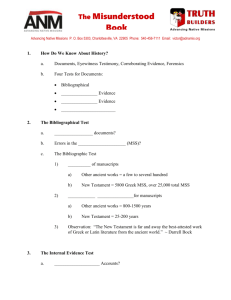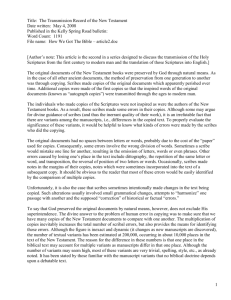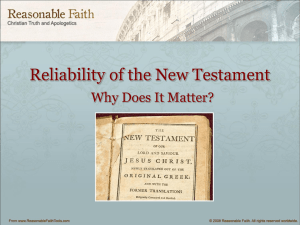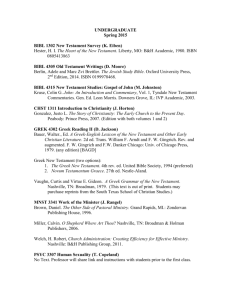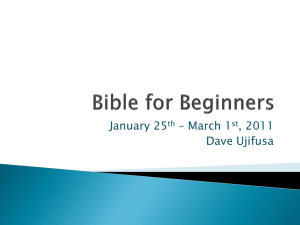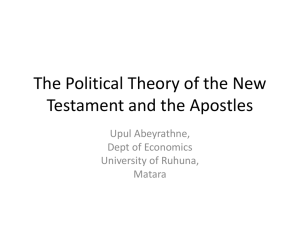Are They Reliable? - The Apostles` Doctrine
advertisement
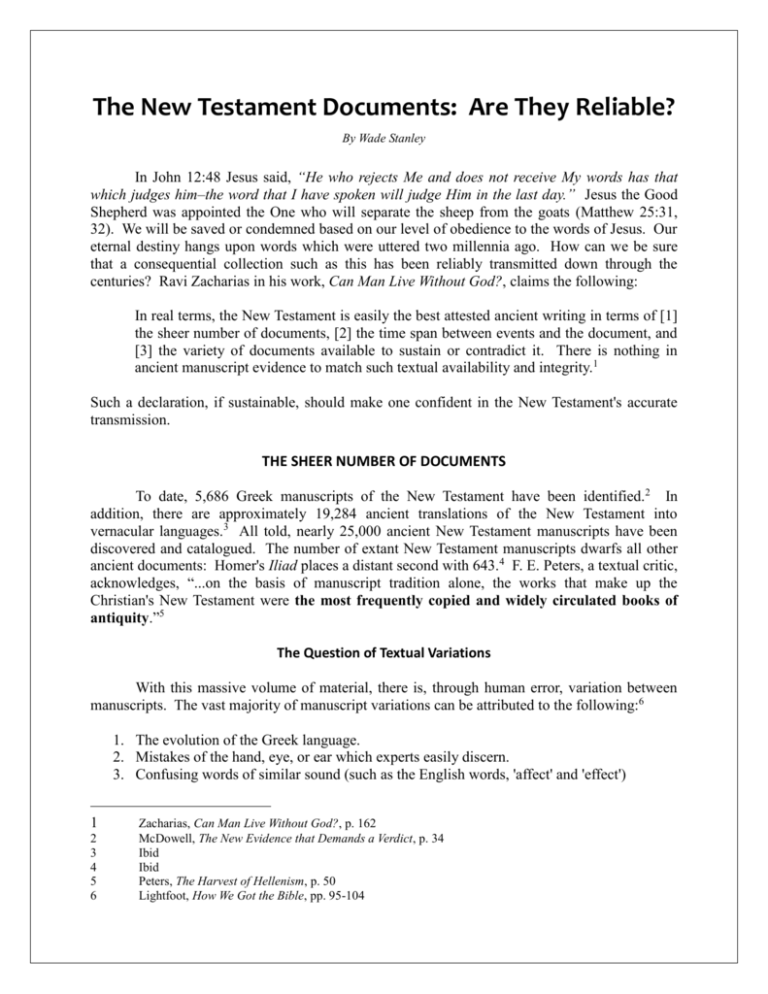
The New Testament Documents: Are They Reliable? By Wade Stanley In John 12:48 Jesus said, “He who rejects Me and does not receive My words has that which judges him–the word that I have spoken will judge Him in the last day.” Jesus the Good Shepherd was appointed the One who will separate the sheep from the goats (Matthew 25:31, 32). We will be saved or condemned based on our level of obedience to the words of Jesus. Our eternal destiny hangs upon words which were uttered two millennia ago. How can we be sure that a consequential collection such as this has been reliably transmitted down through the centuries? Ravi Zacharias in his work, Can Man Live Without God?, claims the following: In real terms, the New Testament is easily the best attested ancient writing in terms of [1] the sheer number of documents, [2] the time span between events and the document, and [3] the variety of documents available to sustain or contradict it. There is nothing in ancient manuscript evidence to match such textual availability and integrity.1 Such a declaration, if sustainable, should make one confident in the New Testament's accurate transmission. THE SHEER NUMBER OF DOCUMENTS To date, 5,686 Greek manuscripts of the New Testament have been identified.2 In addition, there are approximately 19,284 ancient translations of the New Testament into vernacular languages.3 All told, nearly 25,000 ancient New Testament manuscripts have been discovered and catalogued. The number of extant New Testament manuscripts dwarfs all other ancient documents: Homer's Iliad places a distant second with 643.4 F. E. Peters, a textual critic, acknowledges, “...on the basis of manuscript tradition alone, the works that make up the Christian's New Testament were the most frequently copied and widely circulated books of antiquity.”5 The Question of Textual Variations With this massive volume of material, there is, through human error, variation between manuscripts. The vast majority of manuscript variations can be attributed to the following:6 1. The evolution of the Greek language. 2. Mistakes of the hand, eye, or ear which experts easily discern. 3. Confusing words of similar sound (such as the English words, 'affect' and 'effect') 1 2 3 4 5 6 Zacharias, Can Man Live Without God?, p. 162 McDowell, The New Evidence that Demands a Verdict, p. 34 Ibid Ibid Peters, The Harvest of Hellenism, p. 50 Lightfoot, How We Got the Bible, pp. 95-104 4. Variation in proper names and word order also are found, but such conflicts are easily reconciled. For instance, “In Matthew 1:18, is it 'the birth of Jesus Christ' or 'the birth of Christ Jesus'?” (Other manuscripts have 'the birth of Jesus' while others read 'the birth of Christ'.)”7a However, “If the large number of manuscripts increases the total of variations, at the same time it supplies the means of checking them.”7 Geisler and Nix write: The integrity of the Old Testament text was established primarily by the fidelity of the transmission process which was later confirmed by the Dead Sea Scrolls. The fidelity of the New Testament text, however, rests in the multiplicity of the extant manuscripts. Whereas the Old Testament had only a few complete manuscripts, all of which were good, as the result of ancient rabbinical textual work the New Testament has more copies–although of poorer quality (more variants)–which enable the present day textual critic to establish the true text.8 The textual critic “seeks by comparison and study of the available evidence to recover the exact words of the author's original composition. The New Testament critic seeks, in short, to weed out the chaff of bad readings from the genuine Greek text.”9 Thus, through comparative analysis, translators use this mountain of evidence–the sheer number of New Testament documents–to determine, with confident accuracy, the New Testament's original text. The Truth is Still in the Text Although the overwhelming majority of manuscript variation is minor in nature, there are well documented substantial variations. These are few in number and represent material that is contained in other corroborating New Testament passages. In other words, these substantial variations do not alter or amend the New Testament's meaning, since the truth of their message can be confirmed by consulting other passages. Three major passages are generally disputed: Mark 16:9ff, John 7:53-8:11, I John 5:7. Additionally, the English Standard Version of 2001 excludes the following in its translation: Matthew 12:47, 17:21, 18:11, 23:14; Mark 7:16, 9:44, 46, 11:26, 15:28; Luke 17:36, 23:17; John 5:4; Acts 8:37, 15:34, 24:7, 28:29; and Romans 16:24. When examined individually and compared contextually, the reader will find that though disputed, these verses are either recorded in other places or their teaching is corroborated elsewhere. Though modern scholarship questions their inclusion, most conservative translations continue to include these passages, leaving the reader to discern their canonicity. Still some might question the integrity of the text. Since we possess only an overwhelming number of copies and no originals, how can we be sure these copies transmit the originals? Do these errors--though vastly minor in character with a few substantial variations– give us reason to question the authenticity or accuracy of this transmission, since we possess no originals? Edward Glenny asserts, “No one questions the authenticity of the historical books of 7a 7 8 9 Lightfoot, How We Got the Bible, p. 98 Ibid, p. 96 A General Introduction to the Bible, p. 267 Lightfoot, How We Got the Bible, p. 88 antiquity because we do not possess the original copies. Yet we have far fewer manuscripts of these works than we possess of the NT.”10 If we accept the authenticity of Herodotus, Homer, Livy, Thucydides, et al., and consider their works' transmission accurate, though based on less manuscript evidence, why should we not consider the New Testament documents equally or superiorly reliable on the same grounds? Therefore, the vast number of New Testament manuscripts grants significant weight to the belief in an accurate, authentic transmission of the original text. THE TIME SPAN BETWEEN EVENTS AND MANUSCRIPTS The New Testament's textual accuracy is also gauged by the time span between the original events and the oldest discovered manuscripts. The writings of the New Testament chronicle historical events which took place in the first century A.D. Most scholars generally agree that the epistles (or letters) written by first century apostles and prophets were completed by 100 A.D. In his book How We Got the Bible, Neil Lightfoot observes, “Approximately 95% of the existing manuscripts of the New Testament are from the eighth and later centuries...”11 This represents a time gap of at least 600 years between the final events and the significant bulk of manuscript evidence. There are, however, manuscripts whose age dates closer to the events' occurrence and subsequent recording. The Papyri First of all, scholars have not discovered any original manuscripts. The original writings of Matthew, Mark, Luke, John, Paul, Peter, James, and Jude are–so far as we know–lost to antiquity. Thus man has discovered only copies of these original works. The oldest copies discovered so far are incomplete papyri fragments. These fragments, primarily from the second and third centuries, are largely incomplete due to the intense persecution suffered by early Christians. Beginning with Nero and concluding with Domitian, Christians endured at least ten different periods of imperial persecution from approximately 60–300 A.D. Such tumultuous times likely destroyed early, complete manuscript copies of the New Testament. However, some partial copies survived the imperial onslaught. Neil Lightfoot writes: Of the nearly one hundred New Testament papyri presently known, more than fifty are of the fourth century or earlier, and more than thirty are of the third century or earlier. Further, these early papyri cover in part (some in whole) every book of the New Testament except 1 and 2 Timothy. It should be emphasized that these papyri are the ones that just happened to survive.12 The importance of these early papyri should not be underestimated. Geisler and Nix write, “The papyri witness to the text is invaluable, ranging chronologically from the very threshold of the second century, within a generation of the autographs, and include the content of most of the New Testament.”13 Though the majority of extant manuscripts date from the eighth century and 10 11 12 13 Glenny, The Bible Version Debate, p. 96 Ibid, p. Ibid, p. 125 A General Introduction to the Bible, p. 271 beyond, the papyri evidence significantly diminishes the time gap between the actual events and our oldest discovered copies. Three Major Manuscripts However, these papyri are incomplete. Are there more complete ancient manuscripts with a shorter time gap between the events and the copy? The Vatican Manuscript (the Codex Vaticanus) is widely acknowledged to be the most important witness to the New Testament text. It is called the Vatican Manuscript due to its residence in the Vatican Library in Rome since at least 1481. In fact, “it may have been one of the original volumes of the collection” when it opened in 1448.14 It begins with Genesis 46:28; Psalms 106-138 are missing; everything in Hebrews after 9:14 is missing; 1 and 2 Timothy, Titus and Revelation are not present; and Mark 16:9-20 is also missing, but the space to include it is on the parchment.15 The most remarkable fact is its age: the Vatican Manuscript dates from the fourth century A.D.! Thus, we have a nearly complete New Testament manuscript with a time gap of 200-300 years after the original revelation. Older than the Vatican Manuscript is the Sinaitic Manuscript (Codex Sinaiticus) which dates from the mid fourth century (somewhere between 325-350 A.D.). The Sinaitic is a nearly complete copy of the New Testament.16 Finally, we add the Alexandrian Manuscript (Codex Alexandrinus), a fifth century manuscript that contains the Old and New Testaments with the exceptions of Matthew 1:1-25:6, John 6:50-8:52, and 2 Corinthians 4:13-12:6.17 These three nearly complete New Testament manuscripts provide textual evidence that dates from less than three centuries after the original events transpired and were recorded. New Testament Time Gap vs. Other Ancient Literature How does this time gap compare with other works of ancient literature? Using the Codex Sinaiticus as our example, we observe a time gap of 225-250 years based on the New Testament's completion date of 100 A.D. Once again, the New Testament compares favorably with other ancient works. Homer's Iliad comes in second once again with a time gap of 400 years between the date of composition and the oldest manuscript.18 Sir Fredric Kenyon, former director and principal librarian of the British Museum, says, “In no other case is the interval between the composition of the book and the date of the earliest extant manuscripts so short as in the New Testament.”19 This favorable comparison between the New Testament and other ancient documents must factor into its reliability. In his, Introduction to New Testament Textual Criticism, Harold Greenlee argues: Since scholars accept as generally trustworthy the writings of the ancient classics even though the earliest manuscripts were written so long after the original writings and the number of extant manuscripts is in many instances so small, it is clear that the reliability of the text of the NT is likewise assured.20 14 15 16 17 18 19 20 Lightfoot, How We Got the Bible, p. 36 Ibid, p. 38 Ibid, p. 51 Ibid, p. 40 McDowell, The New Evidence that Demands a Verdict, p. 43 Kenyon, Handbook to the Textual Criticism of the New Testament, p. 4 Greenlee, Introduction to New Testament Textual Criticism, p. 16 Thus, textual evidence once again confirms Ravi Zacharias' assertion, that the New Testament is the “best attested ancient writing in terms of...the time span between events and the document.”21 OTHER DOCUMENTS AVAILABLE TO SUSTAIN OR CONTRADICT The Bible testifies very clearly that the gift of divine inspiration which moved the New Testament writers ceased by the early second century A.D. Though God-ordained inspiration and communication concluded, religious writers composed many Christian-oriented works in the second, third, and early fourth centuries. Dubbed by historians “The Ante-Nicene Fathers” (hereafter referred to as the “Ante-Nicene Writers”), these prolific writers authored numerous apologia (defenses of their beliefs), theological treatises, and inter-congregational letters in the two centuries following the New Testament's completion. In terms of textual criticism, their work holds special significance: since their writings were Christian-oriented, they frequently and extensively quoted from New Testament documents. In fact, their quotations are so prolific, textual critics believe that the entire New Testament could be reconstructed based on their writings without the use of manuscripts! Bruce Metzger in his book, The Text of the New Testament, writes, “...so extensive are these citations that if all other sources for our knowledge of the text of the New Testament were destroyed, they would be sufficient alone for the reconstruction of practically the entire New Testament.”22 Sir David Dalrymple posed this very question: what if all the ancient manuscripts were destroyed? Could the NT be reconstructed from the writings of these Ante-Nicene authors? He writes, “...as I possessed all the existing works of [these writers from] the second and third centuries, I commenced to search, and up to this time I have found the entire New Testament, except 11 verses.”23 Such corroborative evidence apart from the manuscripts themselves gives one great reason to accept the authenticity and accuracy of New Testament transmission. CONCLUSION Are the New Testament documents reliable? Based on the aforementioned evidence, the answer must be yes. Although the tide of time, the fallibility of man, and the cruelty of persecutors have worked against it, man has discovered sufficient evidence whose testimony cannot be ignored. The nearly 25,000 ancient manuscripts plus papyri offer a voluminous resource for the textual critic to determine the original revelation's content. The time gap between the recording of events and the oldest copies is shorter than any other ancient document. If all the New Testament manuscripts suddenly disappeared, these documents could be reconstructed from the quotations of Ante-Nicene writers. In short, the New Testament was accurately transmitted down through the centuries. To close, Geisler and Nix offer the following: The abundance of Biblical evidence would lead one to conclude that, 'the Christian can take the whole Bible in his hand and say without fear or hesitation that he holds in it the true word of God, handed down without essential loss from generation to generation 21 22 23 Zacharias, Can Man Live Without God?, p. 162 Metzger, The Text of the New Testament, (p. 86) McDowell, The New Evidence that Demands a Verdict, p. 44 throughout the centuries.' Or, in other words, 'The number of manuscripts of the New Testament, of early translations from it, and of quotations from it in the oldest writers...is so large that it is practically certain that the true reading of every doubtful passage is preserved in some one or other of these ancient authorities. This can be said of no other ancient book in the world.' 24 CHART #1: ANTE-NICENE NEW TESTAMENT QUOTATIONS AUTHOR GOSPEL ACTS S PAUL'S EPISTLES GENERAL EPISTLES REVELATION TOTAL Justin Martyr 268 10 43 6 3 330 Irenaeus 1,038 194 499 23 65 1,819 Clement 1,107 44 1,127 207 11 2,406 Origen 9,231 349 7,778 399 165 17,992 Tertullian 3,822 502 2,609 120 205 7,258 Hippolytus 734 42 387 27 188 1,378 Eusebius 3,258 211 1,592 88 27 5,176 TOTALS 19,368 1,352 14,035 870 664 36,289 Source: McDowell, “The New Evidence that Demands a Verdict”, p. 43 CHART #2: MANUSCRIPT COMPARISON IN TIME GAP AND COPIES AUTHOR BOOK DATE WRITTEN EARLIEST COPY + TIME GAP * NO. OF COPIES Homer Iliad 800 B.C. c. 400 B.C. 400 years 643 Herodotus History 480-425 B.C. c. 900 A.D. 1350 years 8 Thucydides History 460-400 B.C. c. 900 A.D. 1300 years 8 Plato 400 B.C. c. 900 A.D. 1300 years 7 Demosthenes 300 B.C. c. 1100 A.D. 1400 years 200 Livy History of Rome 59 B.C. - 17 A.D. 4th century partial, mostly 10th century 400 -1000 years 19 Tacitus Annals 100 A.D. c. 1100 A.D. 1000 years 20 Pliny Secundus Natural History 61-113 A.D. c. 850 A.D. 750 years 7 50-100 A.D. 325 A.D. 225 years 5366 New Testament Source: McDowell, “The New Evidence that Demands a Verdict”, p. 38 24 Geisler and Nix, A General Introduction to the Bible, p. 248 + Time Gap Comparison * Manuscript Comparison Time Gap (in years) New Testament Homer Livy Livy Tacitus Tacitus Demosthenes Caesar Homer Demosthenes Number of Manuscripts Caesar New Testament 0 200 400 600 800 1000 1200 1400 1600 0 1000 2000 3000 4000 5000 6000
